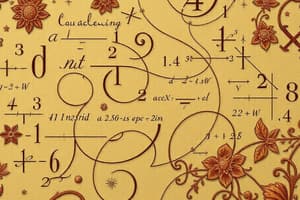Podcast
Questions and Answers
What is the general form of a quadratic equation?
What is the general form of a quadratic equation?
- ax^2 + bx + c = 0 (correct)
- ax^4 + bx^3 + cx^2 = 0
- ax + bx + c = 0
- ax^3 + bx^2 + c = 0
What is the name of the method used to solve quadratic equations that cannot be factorized?
What is the name of the method used to solve quadratic equations that cannot be factorized?
- Quadratic Formula Method (correct)
- Factorization Method
- Completion of the Square Method
- Graphing Method
What type of roots does a quadratic equation have if b^2 - 4ac > 0?
What type of roots does a quadratic equation have if b^2 - 4ac > 0?
- No Real Roots
- Imaginary Roots
- Real and Distinct Roots (correct)
- Real and Equal Roots
What is the shape of the graph of a quadratic equation?
What is the shape of the graph of a quadratic equation?
What is the name of the vertical line that passes through the vertex of the parabola?
What is the name of the vertical line that passes through the vertex of the parabola?
What type of quadratic equation has a coefficient of x^2 equal to 1?
What type of quadratic equation has a coefficient of x^2 equal to 1?
What is one of the applications of quadratic equations?
What is one of the applications of quadratic equations?
What is the formula used to find the roots of a quadratic equation that cannot be factorized?
What is the formula used to find the roots of a quadratic equation that cannot be factorized?
Flashcards are hidden until you start studying
Study Notes
Quadratic Equations
Definition
- A quadratic equation is a polynomial equation of degree two, which means the highest power of the variable (x) is two.
- General form: ax^2 + bx + c = 0, where a, b, and c are constants, and a ≠ 0.
Types of Quadratic Equations
- Monic Quadratic Equation: A quadratic equation in which the coefficient of x^2 is 1.
- Non-Monic Quadratic Equation: A quadratic equation in which the coefficient of x^2 is not 1.
Methods of Solving Quadratic Equations
- Factorization Method: Factor the left-hand side of the equation, if possible, and equate each factor to zero to find the roots.
- Quadratic Formula: If the equation cannot be factorized, use the quadratic formula: x = (-b ± √(b^2 - 4ac)) / 2a.
Nature of Roots
- Real and Distinct Roots: If b^2 - 4ac > 0, the equation has two real and distinct roots.
- Real and Equal Roots: If b^2 - 4ac = 0, the equation has two real and equal roots.
- Imaginary Roots: If b^2 - 4ac < 0, the equation has two imaginary roots.
Graph of Quadratic Equations
- Parabola: The graph of a quadratic equation is a parabola that opens upwards or downwards.
- Vertex: The vertex of the parabola is the lowest or highest point, depending on whether the parabola opens upwards or downwards.
- Axis of Symmetry: The axis of symmetry is the vertical line that passes through the vertex of the parabola.
Applications of Quadratic Equations
- Projectile Motion: Quadratic equations are used to model the trajectory of projectiles under gravity.
- Optimization Problems: Quadratic equations are used to solve optimization problems, such as finding the maximum or minimum value of a function.
Quadratic Equations
Definition
- A quadratic equation is a polynomial equation of degree two, with the highest power of the variable (x) being two.
- The general form of a quadratic equation is ax^2 + bx + c = 0, where a, b, and c are constants, and a ≠ 0.
Types of Quadratic Equations
- A monic quadratic equation is a quadratic equation with a coefficient of x^2 equal to 1.
- A non-monic quadratic equation is a quadratic equation with a coefficient of x^2 not equal to 1.
Methods of Solving Quadratic Equations
- The factorization method involves factorizing the left-hand side of the equation, if possible, and equating each factor to zero to find the roots.
- The quadratic formula is used to solve quadratic equations that cannot be factorized: x = (-b ± √(b^2 - 4ac)) / 2a.
Nature of Roots
- If b^2 - 4ac > 0, the equation has two real and distinct roots.
- If b^2 - 4ac = 0, the equation has two real and equal roots.
- If b^2 - 4ac < 0, the equation has two imaginary roots.
Graph of Quadratic Equations
- The graph of a quadratic equation is a parabola that opens upwards or downwards.
- The vertex of the parabola is the lowest or highest point, depending on whether the parabola opens upwards or downwards.
- The axis of symmetry is the vertical line that passes through the vertex of the parabola.
Applications of Quadratic Equations
- Quadratic equations are used to model the trajectory of projectiles under gravity.
- Quadratic equations are used to solve optimization problems, such as finding the maximum or minimum value of a function.
Studying That Suits You
Use AI to generate personalized quizzes and flashcards to suit your learning preferences.




